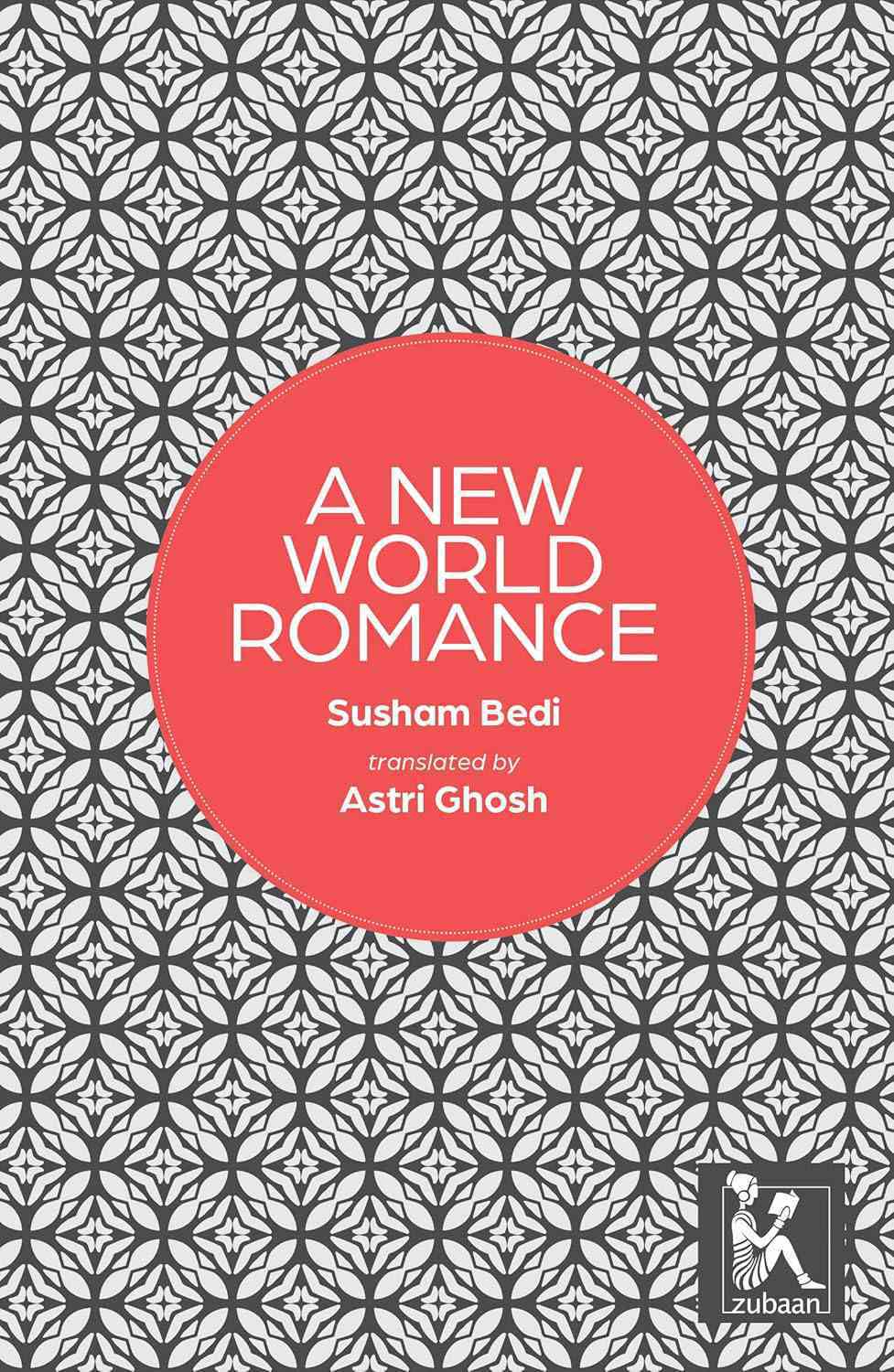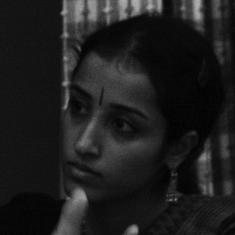In 1955, when Barbara Pym wrote, “the course of true love or academia never did run smooth”, she could not have foreseen how aptly her words would describe Susham Bedi’s epic novel, Navabhum ki Ras Katha. Bedi’s novel, published in 2002, has been rendered into English from Hindi by the artful Astri Ghosh as A New World Romance.
As both the title and Pym’s quote suggest, the novel is anchored in romance and academia. And like any academic romance, literary or filmy, it has two professors, Ketaki and Aditya, as its protagonists. The novel is “the story of two people”, and this is how the narrator sets the scene for the readers. However, we are not immediately introduced to them. We await their arrival as the omniscient narrator provides a broad sweep of the likeness and the unlikeness between Navabhum, the New World – or Gaurbhum (the Land of the Fair-complexioned), very much a reference to the US – and Purabhum, the Old World. This comparison assumes a vocabulary of colours, its grammar the various shades of negating or affirming distance in and through love.
The narrator meanders, though this wandering is deliberate as if to prompt curiosity and shape the readers’ expectations. Love is not a universally rooted emotion, and the narrator talks about the differences in its reception in Navabhum and Purabhum. In Navabhum, love seems plausible and is not absolutely predicated on caste, colour, class, shame, and honour as in Purabhum. The soil of Navabhum seeks to mitigate the distance between lovers, unlike the soil of Purabhum. With this stark contrast, the narrator deftly alludes to the long-narrated tales of Laila-Majnu, Sohni-Mahiwal, and Shakuntala-Dushyant to pronounce how her tale is different from the tragedy of these Purabhum lovers. There is no shame about age since the protagonists are quadragenarian, have already been previously married (not to each other) and separated, and are certainly not virgins. Since the protagonists came from Purabhum, the narrator terms her tale a “hybrid story” – an interesting choice, for it suggests experimentation with both form and content. She identifies herself as Susham Bedi, or nearly does so, towards the end of the prologue and proximates herself with the protagonists by reiterating her own position as a hybrid writer from both Purabhum and Navabhum.
She divides the story into four parts – purvarag, or the dawning of love; ayog, or semi-union; sanyog, or union; and viyog, or parting. The parting is succeeded by an epilogue, and is a clever attempt at approximating this work to the classical works of Kalidasa and Jayasi.
Measured affections
By the time we encounter the protagonists, the two have already shared a fleeting glimpse, their hearts attentive the moment their gaze met. Their meeting is more serendipitously circumstantial than planned. Both have arrived for an academic conference, and in this pre-Internet era – when flights and hotel bookings were arranged over the phone rather than in seconds online – there is nothing that happens instantly; love unfolds at its own pace. Ketaki’s reservation at a hotel does not come through, and Aditya suggests that she take up his room for the night. The prospect seems promising, and Ketaki agrees to it. However, things do not go as planned, and since Aditya cannot lodge with his other colleagues, he is forced to spend the night with Ketaki in his formerly booked room. This room provides the ready soil where the germinal seeds of love would flourish – the room is teeming with anxieties, with promises of possibilities, but a haze unsettles love from lust.
As readers, we have access to the protagonists’ interiority – we know that they have fallen for each other, that a thread is beginning to affect them but they need to tread carefully. Flirting comes easily to them, manifested through the gestures of attending presentations, exchanging notes and feedback, and sending books (the definite promise of love, functioning as a “mantra; the minute you chant it, you get a chance to contact your lover”). They are witty in their nok-jhok, their banter, but these exchanges are laced with anxieties as well. I recall Ketaki’s exchange with Aditya when they were spending some time together on an island. She blurts out her anxiety quite poetically, “I don’t even know the difference between who is mine and who is a stranger any longer.” Very soon, these exchanges acquire a more concrete shape; the thread begins to tug and tighten its grip around them as the distance between them shortens significantly through regular phone calls, faxes, and flying out. Their acquaintanceship graduates to companionship, and the scholarly paraphernalia initially exchanged functions no longer than footnotes.
What both Ketaki and Aditya seek is love but how they seek it spells out the cracks in their newly formed relationship. The narrator reminds the readers that Ketaki, a self-professed procrastinator, seems to delay love and postpone her desires while Aditya remains unfazed in his quest. He is certain that he wants Ketaki not for “her body” but for her “mind.” Ketaki, on the other hand, yearns for an alignment with the “soul.” The schism between mann (mind) and atmann (soul) forms the crux of this modern-day meditation on love; the partial impossibility of its unison made evident when Ketaki loses her balance over some pebbles after Aditya requests her to allow him to “keep loving (you), that’s all I ask.”
In this ras-katha, love propels the action as well as complicates it. Love becomes the antagonist, and the action rests on the mechanics of this intensely sly emotion. Once the “honeymoon phase” of romance wanes, Ketaki finds herself unable to “put all her eggs in one basket” while Aditya is ready to parcel out his entire being to her – he proposes to take up an academic position at her university and vice versa so as to negate the “tragedy” of “not living together” (certainly an ideal move for romances and marriages between academics to pan out in contemporary situations!). However, cohabitation does not guarantee the flourishing of love. Ketaki’s anxieties are fuelled when Aditya does not hesitate to give in to the joys of picturing a “domestic romance.” He seems to assert his familiarity onto Ketaki. For all his scholarly attributions, Aditya reveals himself to be just any other man. He is no “postcolonial hero” that the narrator promises him to be at the onset. Ketaki’s worst fears have been uttered. Love is now a task that requires commitment and no playful flirtation. It begins to assume the shade of a domestic chore, and Ketaki is not ready to “jump into that well” again. Her dilemma is compounded and mapped as she transitions from composing complete poems to incomplete ones for Aditya.
Meanwhile, the spectre of exes from Ketaki’s past assails Aditya. Unable to separate his professional instincts from his personal life, he reads too much into things and overanalyses gestures and interactions, assuming Ketaki harbours an interest in her colleague, Ajay. His actions are a complete disavowal of his promise that his love would be unencumbered, that his love won’t demand surrender from Ketaki, but he turns out to be “even more suspicious and narrow-minded” than Ketaki’s ex-husband.
Their pursuit of love transmutes into a pursuit of the self. Their world splits open to reveal the axis where the protagonists place their hopes and desires; there is a clear chasm between Ketaki’s realism and Aditya’s idealism. Their story, however, does not end in viyog, or parting. The narrator, aware that she has told a story of romance blooming in the New World, speculates and gently nudges readers to choose the ending that best aligns with their sensibilities. We circle back to where we started – the friend who visits the narrator with a “love-related incident or accident” is revealed to be Ketaki, her story just divulged to us.
The epic novel captures the human condition at its finest through the simple premise of two academics in love. Love cannot be reasoned with, and neither Ketaki nor Aditya can penetrate the mystery of this elusive emotion through their various theories, ranging from the Oedipus complex to the Electra complex or the various attitudes ranging from monogamy to polyamory. Perhaps this is also how love is revealed to be a universal emotion, mystifying all. The frustrations of commoners in love are very much the frustrations of the high-browed in love, and most importantly, the story magnetises the gaze on the differences in reception of love by men and women. Love has never been free for women, and this is a thread that runs along the axis of time and space, binding all women across centuries, in the Navabhum as well as the Purabhum, together.
Content with form
While much has been discussed about the content, I would like to sharpen my focus on the form of the novel. Bedi’s ingenuity is revealed through the elegant structuring of this experimental work. Interspersed with poems and layered with intertextual references ranging from Rilke to Bill Clinton, I would not hesitate to call it an “epic novel.” Love comes undulating to us, embodied, and seamlessly translated, allowing readers to savour the rasas through the characters – a testament to the translator Astri Ghosh’s brilliance.
The prologue’s commentary on the distance and difference between the New World and the Old World may be considered a commentary on the craft of translation – “Well, maybe it does not matter where they are from. Especially if you are talking about emotions like the flavour of love, which encapsulates all feelings, all you need for that is two hearts that beat. It can happen anywhere on earth in the heavens or even the space between heaven and earth.”
Ketaki and Aditya may have been “so firmly fixed on their axes that it was difficult for either of them to move”, but Ghosh traverses to bring lovers of words closer to Bedi’s text – her creativity to keep ghazals, the lyrics in the original and then followed by their translation was fascinating. More fascinating was her choice to stick to the good old Hindi names of the flora and fauna – a conundrum that I struggle with. And consider the glimmer of this translated line: “the comet of misfortune plummets to earth like this.” I was in conversation with the work throughout, existing in the marginalia with Ketaki and Aditya, relating to their timeless story, and layering it with intertextual references from the present.
Bedi’s story lingers; it is effervescent. It keeps you alive as you feel Ketaki’s anger and Aditya’s frustration. As readers, you may think that you know the solution to their malady. One feels like reaching out to them, telling them that love is supposed to be self-illuminating – that they should not “be killing themselves through the death of separation” to keep love alive, that waqt ki qaid mein zindagi hai magar, chand gharriyan yehi hein jo azad hein (perhaps, this is what the narrator has in mind when she envisions three alternative endings, but sadly enough, the onus is on Ketaki). However, time is always out of joint, and the novel tells us that the relation between what we feel and what we know may never be negotiated.
Sonakshi Srivastava is a senior writing tutor at Ashoka University, translations editor at Usawa Literary Review, and educational arm assistant at Asymptote.

A New World Romance, Susham Bedi, translated from the Hindi by Astri Ghosh, Zubaan Books.










